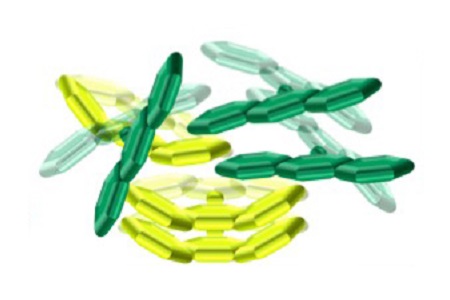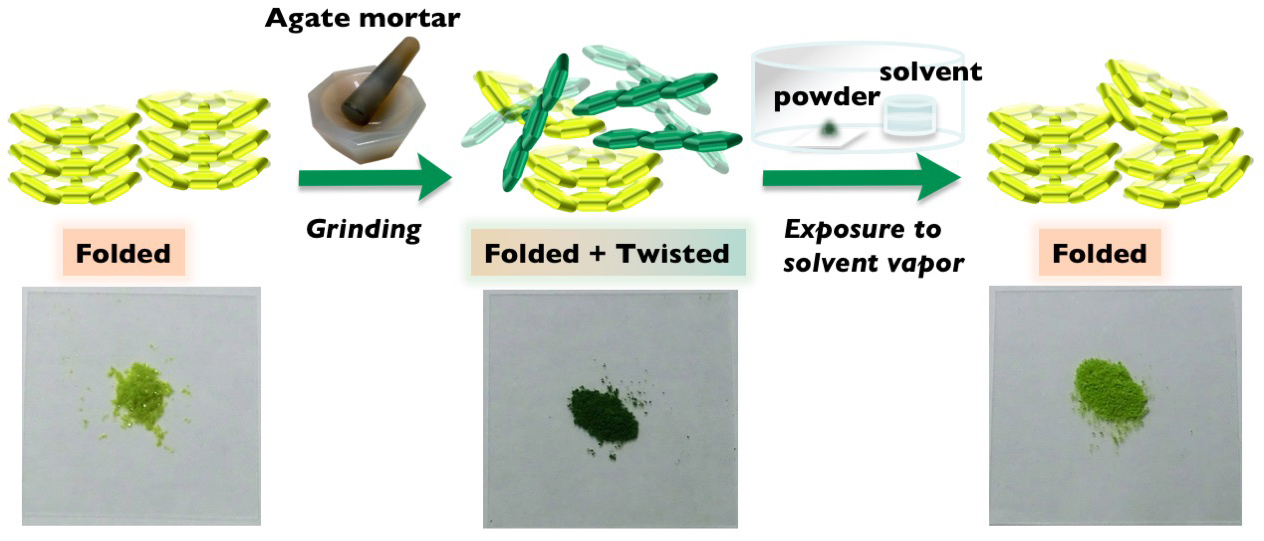New molecule responds to mechanical pressure with drastic color change Mechanical stimulus also enhances electron mobility


By applying mechanical stress, a yellow powder containing a folded conformer changes into a dark green powder with a twisted conformer. Through exposure to a solvent vapor, the color of the powder becomes yellow again. (URL of movie, http://www.matsuo-lab.net/file/FAmovie.mp4)
© 2018 Yutaka Matsuo.
A University of Tokyo research group synthesized a material that undergoes drastic changes in coloration due to color absorption induced by grinding. Scientists are now zoning in on so-called mechanochromic materials — materials that change properties when external mechanical stimuli, such as pressing or grinding, are applied — as new functional materials that can be used in sensors and switches.
Although many materials change luminescent color, or the color created by light emission, when subjected to a mechanical stimulus, few are known to change their absorption color.
In the current study led by Project Professor Yutaka Matsuo at the University of Tokyo’s Graduate School of Engineering, researchers discovered that the color of a molecule named fluorenylidene-acridane that is yellow in a crystalline state turns dark green when the crystals are ground. This is an opposite phenomenon to the crystals of ordinary organic molecules taking on a slightly pale tint when they are ground. The key mechanism of this new phenomenon by which the color becomes darker is the morphological change that successfully links the macro stress — the mechanical stimulus of grinding — to the micro change — the transformation in the form and structure of the molecule. Furthermore, the research group succeeded in enhancing electron mobility in materials with this change.
This molecule, which can take the information of a mechanical stimulus entered into it as input information and convert that into two different output information, as a change in color appearance and electric property, holds promise of becoming a functional material applied to new organic electronic devices, such as touch panels that change color and stress sensors that use optical and electrical outputs for detection.
“By chance, while we were developing materials for organic solar cells, we found a molecule showing drastic color change through grinding,” says Matsuo. He continues, “More than a year later, we were able to reveal the science behind this phenomenon.”
Papers
Tsuyoshi Suzuki, Hiroshi Okada, Takafumi Nakagawa, Kazuki Komatsu, Chikako Fujimoto, Hiroyuki Kagi, Yutaka Matsuo, "A fluorenylidene-acridane that becomes dark in color upon grinding – ground state mechanochromism by conformational change," Chemical Science: November 14, 2017, doi:10.1039/c7sc03567e.
Link (Publication , UTokyo Repository
, UTokyo Repository )
)
Related links
- Graduate School of Engineering

- Department of Mechanical Engineering, Graduate School of Engineering

- Maruyama Laboratory, Department of Mechanical Engineering, Graduate School of Engineering

- Matsuo research group






